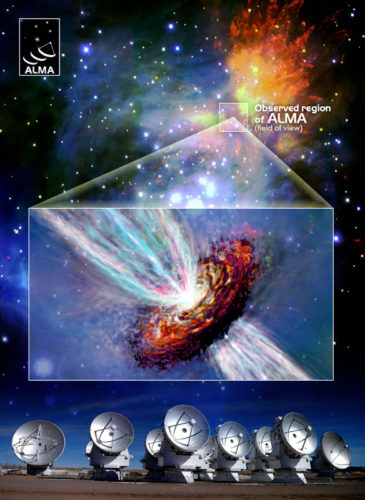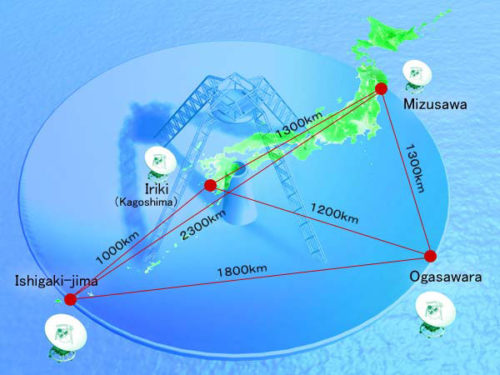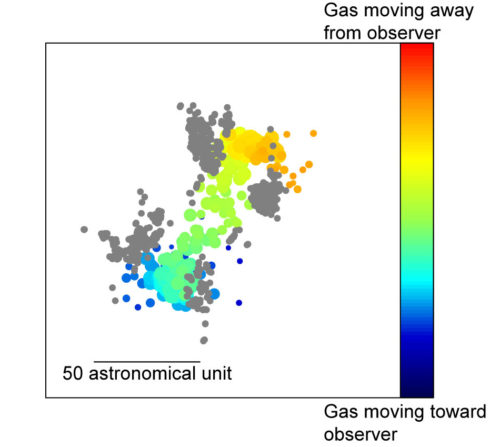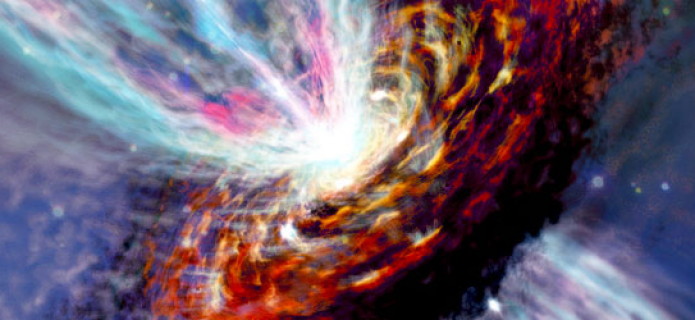ALMA Helps to Explain Massive Stars Mysterious Formation
A research team led by Tomoya Hirota (National Astronomical Observatory of Japan: NAOJ) discovered a hot circumstellar disk around a massive protostar by using the Atacama Large Millimeter/Submillimeter Array (ALMA) and the VLBI Exploration of Radio Astrometry (VERA) [1]. The formation process of a massive star has been a long-standing problem. The research results favor disk accretion for the formation of massive stars, similar to the formation of low to intermediate mass stars such as the Sun.
The team observed a radio source called Source I in Orion KL, the nearest massive star-forming region. ALMA detected radio signals from hot water vapor with high angular resolution. The gas temperature reaches around 3000 degrees Celsius. Combining this data with the data taken by VERA, the team confirmed that the hot gas containing water vapor is actually a circumstellar disk around Source I. Thanks to an accurate estimated distance to Source I based on VERA observations, the disk diameter can be estimated at about 80 times larger than the distance between the Sun and Earth.

Fig. 1 (box): Artist’s impression of Orion KL Source I Credit: NAOJ; Fig 2 (Background): Near-Infrared image of the Orion Nebula taken by the Subaru Telescope. Orion KL is located inside the orange cloud in upper right. The field of view of the ALMA observations is shown with a red circle. Credit: NAOJ; Fig 3: The Atacama Large Millimeter/submillimeter Array (ALMA), ALMA(ESO/NAOJ/NRAO), R. Hills.
Thanks to recent intensive studies, the formation process of low to intermediate mass stars is now well understood. On the other hand, we know little about how massive stars form. Low and intermediate mass stars are formed by mass accretion from a circumstellar disk. Is this process the same for massive stars? Massive stars could form via stellar collisions as another theory suggests. We cannot answer such a simple question.
A radio telescope is essential to study the process of star formation because stars form in gas and dust, and a radio telescope observes such interstellar matter. For high resolution, observations by a radio array have a great advantage. Until very recently, the resolution and sensitivity of observational instruments were not high enough for detailed investigations of molecular clouds in which massive stars are forming. To make matters worse, most such clouds are located far from our Solar System. Now, ALMA enables researchers to study actual formation sites of massive stars.
The research team selected the nearest region of massive star-formation, Orion KL, for the ALMA observation. Stars with 8 times more mass than the Sun are forming in Orion KL. The distance to Orion KL is estimated to be about 1400 light-years, and it has been well studied since its discovery in 1967 because of its vicinity.

Fig. 4: Antenna locations of the VERA array. Credit: NAOJ
The research team carried out observations of Source I in Orion KL with VERA. The team observed the launching point of a bipolar outflow, and found a cluster of vibrationally excited SiO masers tracing an outflow arising from the surface of the disk. The team uncovered a high-speed jet from the region surrounding Source I by observing the SiO masers. The other research group found a compact radio continuum source associated with the center of these vibrationally excited SiO masers. This radio source is interpreted as an edge-on disk. However, the nature of Source I is still controversial. The structure of this region is complex. Many large and small jets are blowing off in various directions. Thus, interpretation of the observations was sometimes different and some researchers deny the existence of the disk and jets.
Previously, the research team successfully found radio signals emitted by high temperature water vapor by analyzing ALMA’s data. When the data was taken, ALMA was in the science verification phase before full operation so the resolution was not high enough to uncover the nature of the molecular gas associated with the hot water vapor. Hirota, the leader of this study, said, "We proposed additional ALMA observations to understand Source I. We got very good quality data! The resolution is three times higher than the previous data set."
The team used the two radio lines emitted by water molecules at the frequencies of 321 GHz and 336 GHz, which are thought to correspond to gas temperatures of 1700 and 2700 degrees Celsius, respectively. Thus, these lines are suitable tracers to study the closest region of Source I.

Fig. 5: Distribution of the radio emission from water molecule at 336 GHz observed by ALMA. The color indicates the motion of the water molecule; blue means the gas moving toward us and orange indicates the gas moving away from us. The gray dots shows the distribution of the SiO maser emission detected by VERA. Researchers interprets that the SiO maser traces the root of the jet.
The team detected the two lines from the hot water molecules and clearly revealed the distribution. The distribution of the emissions from the 1700 degrees Celsius water molecules was similar to that of the jet observed via the SiO maser. The team interpreted this to mean that water molecules in the jet from Source I are emitting the radio maser.
The radiation from water molecules at 2700 degrees Celsius was found to have a structure similar to that of Source I at the base of the jet. Interestingly, the team found that this hot gas seems to have a disk-like shape. Detailed analysis indicates that the rotational velocity of the disk is 10 km per second.
The team also found;
- The temperature of the rotating disk reaches 3000 degrees Celsius or higher.
- The central star should have at least 7 times more mass than the Sun.
- The diameter of the disk is estimated as about 80 times larger than the Solar System.
- The radio emissions come from a rotating ring-like structure or limb of the disk viewed edge-on.
One of the team members, Mareki Honma, said, "Our observations uncovered the nature of Source I, and we can understand the previous observational results about Source I in a consistent manner. These are all thanks to ALMA. Thanks to this state-of-the-art telescope, we can observe the target at higher frequency and higher resolution. In addition, thanks to VERA, we have a good distance estimate to Source I. This results in accurate estimates for the size of the disk and other physical quantities."
This study settles the long-standing problem; is Source I a jet or a gas disk. The result clearly shows that Source I is a gas disk.
The team wants to learn the more detailed structure and dynamics of Source I by using ALMA with higher resolution and sensitivity at higher frequency. Such observations should reveal the mysteries of the evolution of Source I. Hirota said, "It is also important that the physical conditions of a circumstellar disk depend on the mass of the central protostar. The circumstellar disk around a massive star is heated up to 3000 degrees Celsius. Dust that is the material for planets should melt away at such high temperatures. I wonder if planets can form under such condition. I’m interested in the dependence of planet formation on stellar mass and physical conditions."
The research findings are presented in the article Hirota et al. "A Hot Molecular Circumstellar Disk around the Massive Protostar Orion Source I" published in the Astrophysical Journal in February 2014.
Notes
[1] VERA is a Japanese very long baseline interferometer (VLBI) network operated by NAOJ
More Information
The Atacama Large Millimeter/submillimeter Array (ALMA), an international astronomy facility, is a partnership of the European Organisation for Astronomical Research in the Southern Hemisphere (ESO), the U.S. National Science Foundation (NSF) and the National Institutes of Natural Sciences (NINS) of Japan in cooperation with the Republic of Chile. ALMA is funded by ESO on behalf of its Member States, by NSF in cooperation with the National Research Council of Canada (NRC) and the Ministry of Science and Technology (MOST) in Taiwan and by NINS in cooperation with the Academia Sinica (AS) in Taiwan and the Korea Astronomy and Space Science Institute (KASI).
ALMA construction and operations are led by ESO on behalf of its Member States; by the National Radio Astronomy Observatory (NRAO), managed by Associated Universities, Inc. (AUI), on behalf of North America; and by the National Astronomical Observatory of Japan (NAOJ) on behalf of East Asia. The Joint ALMA Observatory (JAO) provides the unified leadership and management of the construction, commissioning and operation of ALMA.
Contact:
Tomoya Hirota
Assistant Professor
Mizusawa VLBI Observatory
National Astronomical Observatory of Japan
Phone: +81-422-34-3645
Email: [email protected]
Mareki Honma
Associate Professor
Mizusawa VLBI Observatory
National Astronomical Observatory of Japan
Phone: +81-422-34-3640
Email: [email protected]
Valeria Foncea
Education and Public Outreach Officer
Joint ALMA Observatory
Santiago, Chile
Tel: +56 2 467 6258
Cell: +56 9 75871963
Email: [email protected]
Charles E. Blue
Public Information Officer
National Radio Astronomy Observatory
Charlottesville, Virginia, USA
Tel: +1 434 296 0314
Cell: +1 434.242.9559
E-mail: [email protected]
Richard Hook
Public Information Officer, ESO
Garching bei München, Germany
Tel: +49 89 3200 6655
Cell: +49 151 1537 3591
Email: [email protected]
Masaaki Hiramatsu
Education and Public Outreach Officer, NAOJ Chile
Observatory Tokyo, Japan
Tel: +81 422 34 3630
E-mail: [email protected]
